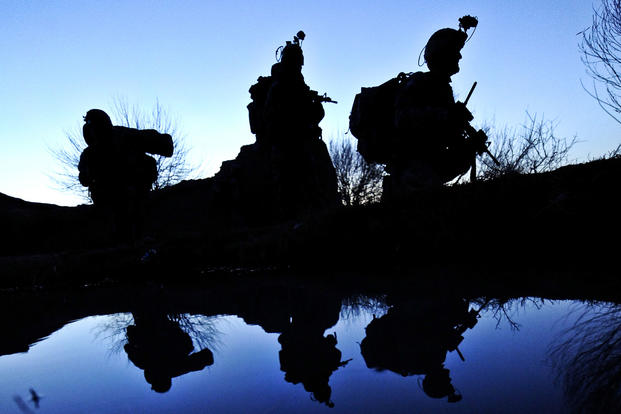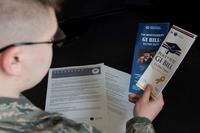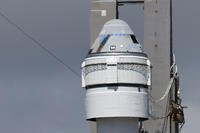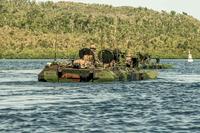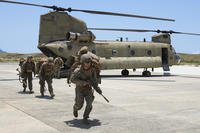Two U.S. troops were killed and one was wounded Wednesday in a firefight during a raid against an ISIS offshoot in the same area of eastern Afghanistan where the U.S. dropped the Massive Ordnance Air Blast bomb earlier this month, U.S. Forces-Afghanistan said Thursday.
The casualties occurred as the American service member partnered with the Afghan National Defense and Security Forces in operations against fighters of the Islamic State of Iraq and Syria affiliate called Islamic State-Khorasan Province, or "ISIS-K."
"The fight against ISIS-K is important for the world, but sadly, it is not without sacrifice," said Army Gen. John W. Nicholson, commander of U.S. Forces-Afghanistan and NATO's Resolute Support mission.
"On behalf of all U.S. forces and our coalition partners, I offer our deepest sympathies to the families, friends, and fellow service members of our fallen comrades," said Nicholson, who began calling in February for the deployment of more U.S. troops to Afghanistan to counter ISIS-K and a resurgent Taliban.
In a sign of continuing U.S. support for the mission, the Army announced that about 1,500 soldiers of the 1st Brigade Combat Team, 82nd Airborne Division, stationed at Fort Bragg, North Carolina, will deploy to Afghanistan this summer in a regular troop rotation in support of the U.S. Freedom's Sentinel mission to shore up the Afghan government.
"The 'Devils in Baggy Pants' are well-trained, well-equipped, and ready to assist our Afghan partners," Col. Toby Magsig, commander of 1st Brigade Combat Team, 82nd Airborne Division, said in a statement.
The identities of the two service members killed in the Achin district of eastern Nangarhar province, the same area where the 21,600-pound MOAB, or "Mother of All Bombs," was dropped April 13 against an ISIS-K cave and tunnel complex, were withheld until next of kin could be notified.
The U.S. has declined to give a damage assessment on the effects of the MOAB, but Afghan officials have estimated that 36-100 ISIS-K fighters were killed. However, fighting in the area resumed immediately after the bombing.
Earlier this month, in the same area of Nangarhar province, Army Staff Sgt. Mark R. De Alencar, 37, of Edgewood, Maryland, was killed in a firefight with ISIS-K fighters. He died of injuries sustained when his unit came in contact with enemy forces using small-arms fire during combat operations, according to an April 10 Defense Department press release.
De Alencar was assigned to 1st Battalion, 7th Special Forces Group (Airborne), at Eglin Air Force Base, Florida. He was the first U.S. combat fatality in Afghanistan this year. In addition, Sgt. 1st Class Robert R. Boniface, 34, of San Luis Obispo, California, died March 19 in Logar province from a non-combat incident.
More than 2,390 U.S. troops have been killed since U.S. forces entered Afghanistan after the Sept. 11, 2001, terror attacks, according to the Pentagon.
American troops have been assisting Afghan forces battling ISIS-K since early last year, when the U.S. designated the group a foreign terrorist organization to allow U.S. airstrikes against it.
Last month, ISIS-K claimed responsibility for a roadside bomb blast that wounded three U.S. soldiers in Nangarhar, where the group has established a foothold near the Pakistan border.
Since 2016, at least 12 of the group's leaders have been killed and the overall number of fighters has been reduced from more than 2,000 to approximately 700, according to U.S. Forces-Afghanistan.
Despite their losses, ISIS loyalists have claimed responsibility for high-profile attacks throughout the country, including the storming of Afghanistan's largest military hospital in Kabul, which killed dozens last month.
On Monday, Defense Secretary Jim Mattis made an unannounced visit to Kabul to assess the deteriorating security situation across Afghanistan and the long-standing request of Nicholson for a "few thousand" more U.S. troops to bolster the train, advise and assist operations.
Currently, the U.S. has about 8,500 troops in Afghanistan, backed by about 5,000 troops from NATO members.
Mattis was also seeking to shore up an Afghan government reeling from its worst defeat by the Taliban, which is now possibly supplied with weapons by Russia.
Mattis arrived in Kabul shortly after President Ashraf Ghani sacked the defense minister and the army chief following a Taliban assault last Friday on a northern base that killed at least 140 Afghan troops.
Before Mattis arrived, the Taliban claimed responsibility for setting off a car bomb at the entrance of Camp Chapman in Khost province. The same base was the target of a 2009 suicide attack by a Jordanian double agent that killed nine, including seven American CIA officers and contractors.
At a news conference with Mattis, Nicholson did not dispute regional reports that Russia, which has acknowledged contacts with the Taliban, is now sending weapons and supplies to the insurgents.
"We continue to get reports of this assistance," Nicholson said. "We support anyone who wants to help us advance the reconciliation process, but anyone who arms belligerents who perpetuate attacks like the one we saw two days ago in Mazar-e Sharif is not the best way forward to a peaceful reconciliation."
Mattis said, "Any weapons being funneled here from a foreign country would be a violation of international law unless they were coming to the government of Afghanistan."
The attack last Friday on the base of the Afghan army's 209th Corps outside Mazar-i-Sharif in northern Balkh province killed at least 140 and the death toll was expected to rise among scores of others who were wounded. It was the worst attack on a military base in Afghanistan since the U.S. entered the country in 2001.
Local reports said that as few as 10 Afghan fighters managed to gain access to the base and fell upon Afghan troops at a mosque and a dining facility with small arms and grenades in a battle that lasted five hours.
Mattis said the attack is evidence that the Afghan government faces a "barbaric enemy. What they do, makes it clear to me why we stand together to defeat them."
However, Mattis said he is still hopeful of a political settlement with the Taliban that could lead to peace. "If the Taliban want to join the political process and work honestly for a positive future for the Afghan people who have suffered long and hard, they need only to renounce violence and reject terrorism," he said. "That's a pretty low standard."
Without a political agreement, Mattis predicted that 2017 would be "another tough year for the valiant Afghan security forces and the international troops who have stood and will continue to stand shoulder-to-shoulder with Afghanistan against terrorism and against those who seek to undermine the legitimate, United Nations-recognized government of this nation."
In response to the attack on the army base, Ghani's office announced that Defense Minister Abdullah Habibi and Army Chief of Staff Qadam Shah Shahim had "stepped down with immediate effect." Despite his resignation, Habibi reportedly attended a meeting with Mattis.
Ghani's office also announced that four army corps commanders had been replaced, and Afghan defense officials said as many as eight army personnel had been arrested on suspicion of aiding in the army base attack, Reuters reported.
-- Richard Sisk can be reached at Richard.Sisk@Military.com.
